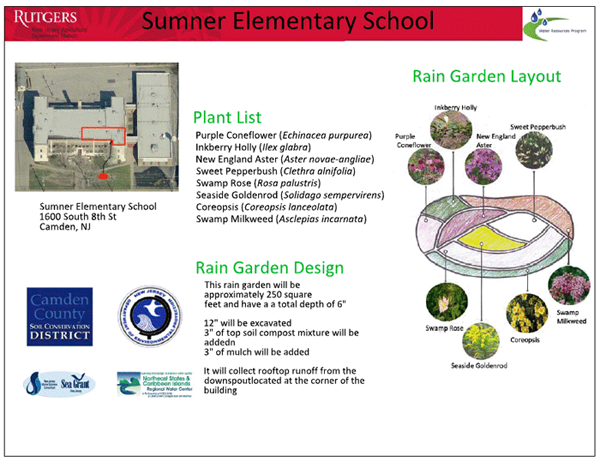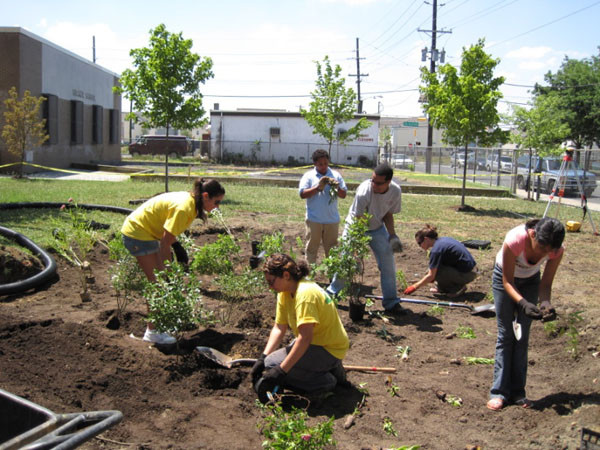 |
August 2012
|
August 2012 // Volume 50 // Number 4 // Ideas at Work // v50-4iw4
Using Rain Gardens to Promote Service Learning and Climate Science Education with Urban Youth
Abstract
The Jersey Roots, Global Reach 4-H Climate Science Program conducted in Camden, New Jersey introduces middle school students to the evidence, impacts, and potential solutions to climate change. For their service learning project, students installed two rain gardens at the school. Rain gardens are shallow landscaped depressions in the soil that can be installed at homes, parks, and schools and provide environmental benefits by filtrating stormwater runoff. Created using native plants, rain gardens are aesthetically pleasing and require minimal maintenance.
Introduction
The Jersey Roots, Global Reach 4-H Climate Science Program conducted in Camden, New Jersey introduces middle school students to the evidence, impacts, and potential solutions to climate change.
Students learn about the difference between weather and climate; the carbon cycle and how increased amounts of carbon dioxide in the atmosphere impact our planet; utilize technology as a means to measure and graph temperature; as well as plan service learning projects that focus on small changes in behavior that can improve the environment.
Students at the Charles Sumner School in Camden also helped install two rain gardens at the school as their service learning project. Rain gardens are shallow landscaped depressions in the soil that can be installed at homes, parks, and schools, and that provide environmental benefits by filtrating stormwater runoff. Rain gardens are created using native plants, are aesthetically pleasing, and require minimal maintenance.
Jersey Roots, Global Reach Climate Science Education
Over the course of two school years, the Camden County 4-H Youth Development Program delivered multi-week climate science programming to more than 110 urban youth at four sites. A scope and sequence for programming was developed and addresses the following four elements:
- Difference between weather and climate
- Evidence of climate change
- Impact of climate change
- Potential solutions through service learning
The Logic Model for this program addresses both short-term and long-term outcomes, including:
- Youth will increase knowledge in climate science
- Youth will develop and demonstrate skills in technology
- Youth will address local climate change issues through service projects
- Youth communicate accurate knowledge about climate change and their share their concerns about climate change and/or climate issues in their communities
The long-term outcome is to increase the capacity of community-based partners to continue with climate science/climate change education at the conclusion of the program in 2014.
In the first year of the program, which was piloted in one classroom with 13 youth, there were dramatic changes in knowledge gained, addressing:
- How to measure weather (58% change);
- Understanding that the atmosphere traps the sun's heat energy and keeps Earth warm (54%);
- The major events in Earth's history that created the weather/climate system (44%);
- Increase in understanding the difference between climate and weather (31%).
The participants' evaluations noted a significant change in how to compare data in recognizing climate trends at 42%.
In the second year of the program, staff worked with 98 youth during the school year. A sampling of youth evaluations (n=18) demonstrated an increase in knowledge and attitudes in the following areas:
- Agreed or strongly agreed on having a better understanding of their community after participating in the program. (94%);
- Agreed or strongly agreed that they learned how to meet a need in their community. (88%);
- Agreed or strongly agreed that they gained confidence in working on community issues (83%);
- Know how to use technology/digital tools to observe and collect data (80% change).
Service Learning
In 2010 and 2011, students planned and installed a rain garden as their service learning project, using an action planning process. This process introduced a framework for identifying a school or community need, creating goals and objectives, developing a project timeline, listing the resources needed, and creating measures of success or expected outcomes.
Additionally, the National Youth Leadership Council's K-12 Service Learning Standards for Quality Practice were used by the 4-H Program to ensure that the eight standards were touched upon. These include: meaningful service; link to curriculum; reflection; diversity; youth voice; partnerships; progress monitoring; and duration and intensity of the program.
The Benefits of a Rain Garden?
According to Obropta, DiNardo, and Rusciano (2008), "A rain garden is a shallow landscaped depression that is designed to capture, treat, and infiltrate stormwater runoff. The plants in a rain garden are native to the region and help retain pollutants." A rain garden is designed to capture runoff from small storms, which, due to their frequency, are responsible for contributing a large amount of nonpoint source pollution (Leopold, 1968; May, Horner, Karr, Mar, & Welsh, 1997). More specifically, benefits to installing a rain garden are to provide flood control, groundwater recharge, and nutrient removal.
One project partner, the Rutgers Water Resources Program, designed both rain gardens, which were installed in June 2010 and June 2011 (Figure 1). The first garden is 340-square feet in size, and the second garden installed is 250-square feet in size. Each is located in a visible place in front of the school, and collects, filters, and infiltrates more than 100,000 gallons of stormwater annually. This is significant, because this water no longer enters Camden's combined sewer and storm drain system, and it helps replenish the Coastal Plain Aquifer System of New Jersey.
Figure 1.
2011 Sumner School Rain Garden Layout

Partnerships
A project such as this could not succeed without strong partnerships. The Service Learning Standard for Quality Practice for Partnerships maintains that partnerships developed through service learning projects are critical to its success. "The planning, sharing, and work that partners do together not only create outcomes that would be unachievable by the students alone, but also enhance the learning experience in immeasurable ways for all involved" (Obropta, DiNardo, & Rusciano, 2008).
The Jersey Roots, Global Reach service project partners included: the Charles Sumner School in Camden, NJ, the Camden County Parks Department in Cherry Hill, NJ, and the Rutgers Water Resources Program at Rutgers University in New Brunswick, NJ. Each partner played an important role in the project. (Figure 2) The school principal, teachers, and students were engaged in the program throughout the 14 weeks; the Camden County Parks Department provided manpower and equipment to enable the rain garden to be installed; and the Rutgers Water Resources Program provided staff to design the rain garden, spearhead the installation, and underwrite the cost of the project through grant funding. The key is that each partner held different sets of knowledge to share with one another and then contributed their skill sets towards the completion of the project.
Figure 2.
Program Partners Included Students, Teachers, 4-H Staff, Rutgers Water Resources Staff and Camden County Employees.

Conclusion
Urban youth have benefited from their participation in the Jersey Roots, Global Reach 4-H climate science program since 2009. Participating in the development and installation of two rain gardens has enabled them to connect climate science curriculum to a real-world environmental project. This provided a meaningful service opportunity for students, allowing for a youth voice to be actively heard. Strong partnerships were developed as a result and allowed for a second rain garden to be installed in 2011.
Those interested in learning more about rain gardens should visit the Rutgers Water Resources Program Rain Garden Information website at http://water.rutgers.edu/Rain_Gardens/RGWebsite/rginfo.html to view an introduction to rain gardens, fact sheets, a services directory, and various articles and presentations on rain gardens.
Acknowledgments
Grant funding was provided by the United States Department of Agriculture Children Youth and Families At-Risk Program for the Jersey Roots, Global Reach 4-H Climate Science Program and the Rutgers Water Resources Program with funding through the U.S. Environmental Protection Agency.
References
Getting Started in Service-Learning, An Elementary Through High School Handbook, National Youth Leadership Council. St. Paul Minnesota. 2010.
Leopold, L. B., (1968). Hydrology for urban land planning--A guidebook on the hydrologic effects of urban land use. U.S. Geologic Survey Circular 554, Washington D.C.
May, C. E., Horner, R. R., Karr, J. R., Mar, B. W., & Welch, E. B. (1997). Effects of urbanization on small streams in the Puget Sound Ecoregion. Watershed Protection Techniques. 2(4): 483-494.
Obropta, C., DiNardo, M., & Rusciano, G. (2008). The demonstration rain garden. Journal of Extension [On-line], 46 (2) Article 2TOT3. Available at: https://www.joe.org/joe/2008april/tt3.php
Rain Gardens, Rain Garden Information Center, Rutgers Water Resources Program. Retrieved from: http://water.rutgers.edu/Rain_Gardens/RGWebsite/rginfo.html




